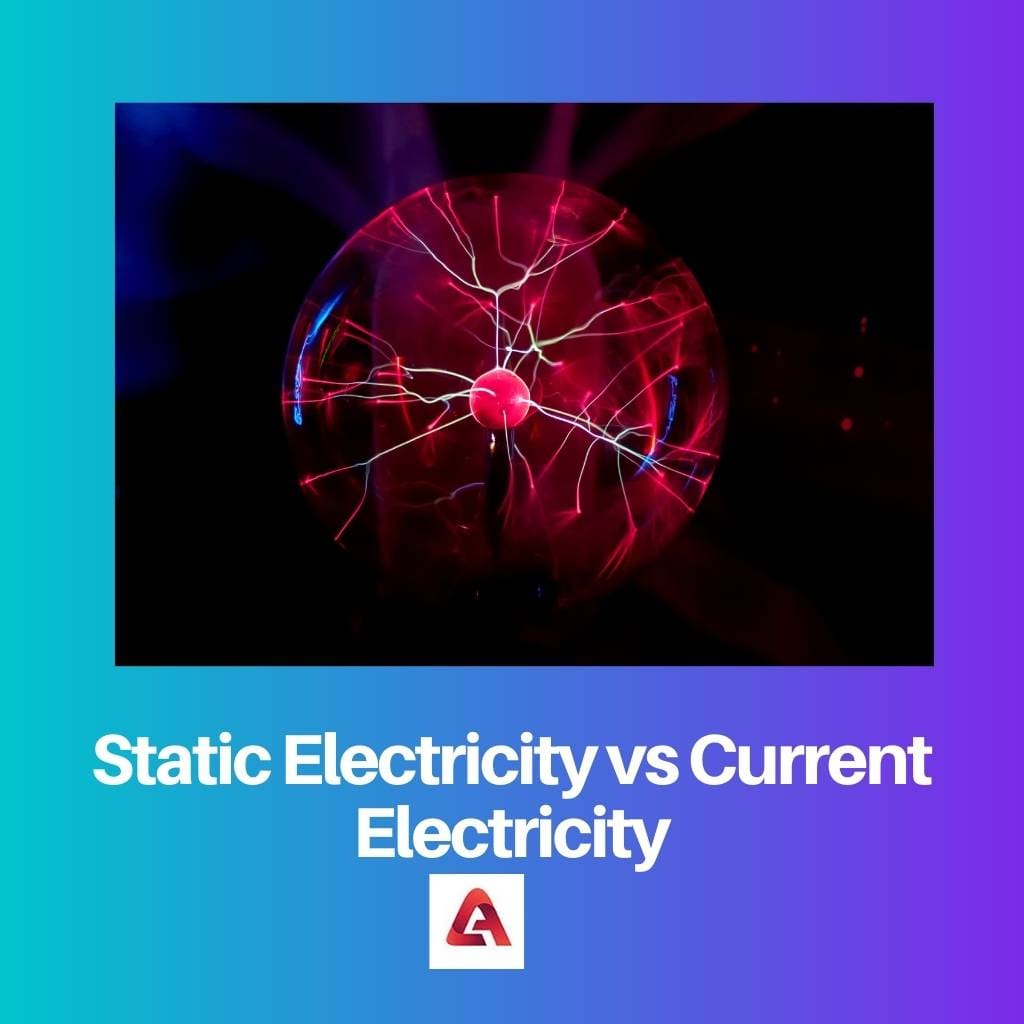Electricity can refer to the energy stored in the body in the form of charged packets or the flow of energy stored in the body in the form of charged packets.
Static electricity is caused by the accumulation of electric charges on the surface of an object, called an insulator, and current is caused by the passage of electric charges through the object (called a conductor).
There are many basic differences between static electricity and electric current.
Key Takeaways
- Static electricity results from an imbalance of electric charges within or on a material’s surface, while current electricity flows through a conductor.
- Static electricity is stationary and builds up in one place, whereas current electricity involves the continuous movement of electrons.
- Static electricity discharges quickly in a single event, while current electricity provides a continuous energy flow.
Static Electricity vs Current Electricity
The difference between static electricity and current electricity is that Static electricity occurs when charges are at rest and accumulate on the insulator’s surface. On the other hand, electrons propagate in the conductor in the electric current. Static electricity can be used in pollution control equipment, and paint sprayers. Although current energy is used for various tasks, such as fan operation and motor operation

When the charge cannot find a way to equalize, electrostatic discharge occurs. The charges attract each other so strongly that they can even pass through even the most effective insulators.
Depending on the medium through which the charge passes and the surface to which the charge is transferred, electrostatic discharge can be dangerous.
Current electricity is the kind of energy that allows us to use all of our modern gadgets. This kind of electricity exists when the electric charge can flow continuously.
Contrary to static electricity, where charges accumulate and remain stationary, the current is dynamic, where the charge is always moving. Current electricity requires a circuit to flow: a closed, never-ending loop of conductive material.
Comparison Table
| Parameters of Comparison | Static Electricity | Current Electricity |
|---|---|---|
| Definition | Static electricity refers to the electricity that accumulates on a substance’s surface. | The movement of electrons is responsible for current electricity. |
| Material | In both the conductor and the insulator, static electricity forms. | The current electricity is formed only in the conductor |
| Causes | It occurs because negative charges flow from one item to another. | The mobility of electrons is responsible for current electricity. |
| Magnetic Field | There is no magnetic field produced by static electricity. | When an electric current is generated, a magnetic field is produced. |
| Time period | Short time | Long time |
What is Static Electricity?
The term “static” refers to a situation in which something is not moving. Static electricity is the static charge on the surface of the material. Rub two electrostatic objects together to generate static electricity.
Everything is made up of atoms, and atoms are microscopic particles. The nucleus and free electrons make up an atom. Neutrons and protons are evenly distributed throughout the nucleus. The atom’s electrons travel around in their orbit.
Some of the substance’s free particles are weakly bonded. When the two items are rubbed together, electrons with weak bonds hop from one object to the other.
When the electron is removed from the object, it will be positively charged. And the electron-gaining item becomes negatively charged.
When moving electrons collide with electrons in the air, the electrons in the air are excited and release energy in the form of light, so balancing the charge through the air gap may cause visual shock.
Static electricity is caused by the potential generated by static electricity.

What is Current Electricity?
Current electricity is the electricity that is generated as a result of the movement of electrons. It can only be formed on materials with unbound electrons.
Current electricity is used to accomplish mechanical tasks such as moving a fan or operating a machine. Due to the electric current, the magnetic field is combined.
Electric current is divided into AC (alternating current) and DC (direct current).
Charges in direct current only travel in one direction. The atom is a material made up of very small particles. The nucleus and electrons make up the atom.
The nucleus is stationary, while the electrons move around the atom’s orbit. One has electrons that are weakly bound, whereas the other contains electrons that are firmly bound.
The conductor is a material that has a weak connection between electrons and atoms.
When an external force (such as voltage) acts on it, heat energy is released, and the electrons are excited to transition from one atom to the next atom in the conductor.
The current electricity is generated by the movement of electrons. The electrons in non-metals are tightly bound. On the other hand, due to the repulsive properties of electric charges, electrons jump from one atom to the next in the metal.
The current electricity is generated by the movement of electrons.

Main Differences Between Static Electricity and Current Electricity
- Static electricity is defined as electricity in which charges stay static. Current electricity, on the other hand, is created by the flow of charges.
- Static electricity forms on the insulator and conductor surfaces, while current electricity forms solely in the conductor.
- The transfer of negative charges from one item to another causes static electricity to form. The movement of electrons in the atoms of the conductor produces current electricity.
- The magnetic field is created by current electricity, and it has nothing to do with static electricity.
- Static electricity is only present for a short time, while current electricity is present for a long time.

- https://www.tandfonline.com/doi/abs/10.1080/02635140701250857
- https://iopscience.iop.org/article/10.1088/0508-3443/4/S2/302/meta

The article effectively dissects the principles of static and current electricity, offering valuable insights into their fundamental characteristics.
The article’s detailed exposition of static and current electricity offers readers a comprehensive understanding of the key distinctions and applications of these essential concepts.
Absolutely. The article’s meticulous breakdown of static and current electricity contributes to an enriched comprehension of these fundamental principles.
The article offers a comprehensive comparison between static and current electricity, shedding light on their distinct properties. This knowledge is invaluable for understanding the fundamental principles of electrical systems.
I couldn’t agree more. The article provides an insightful analysis of static and current electricity, enhancing readers’ understanding of these fundamental concepts.
The comparison table and explanations are helpful to differentiate static electricity from current electricity. I find the details quite informative.
Absolutely, I found the table to be particularly useful in summarizing the key points of differentiation between static and current electricity.
The article provides a clear understanding of the difference between static electricity and electric current. It is important to know the distinction between the two as they play vital roles in our everyday lives.
I appreciate how the article delves into the details, providing a comprehensive overview of static and current electricity.
Agreed, the article does an excellent job of explaining the intricate concepts in a simple and organized manner.
The article explains the intricate concepts of static and current electricity with great clarity, making it accessible to readers with varying levels of familiarity with the subject.
Absolutely. The systematic approach to elucidating the differences between static and current electricity is commendable.
I find that the article does an excellent job of addressing the complexities of static and current electricity in an engaging and illuminating manner.
The thorough explanations and detailed analysis in the article demonstrate a high level of intellectual rigor, contributing to an enriched understanding of static and current electricity.
Absolutely. The depth of understanding conveyed in this article serves to enlighten readers about the nuances of static and current electricity.
The article provides a rich exploration of static and current electricity, enhancing readers’ understanding of the fundamental principles that govern these phenomena.
Indeed. The article’s comprehensive analysis of static and current electricity serves to deepen readers’ knowledge of these fundamental concepts.
The article’s content is valuable in describing the characteristics of static and current electricity. This is important knowledge for understanding the applications of electricity in various fields.
The article effectively presents a detailed overview of static and current electricity, offering readers a solid foundation to grasp these concepts.
I completely agree. The knowledge of static and current electricity is fundamental in comprehending the principles of electrical systems.
The comprehensive comparison and detailed explanations provide readers with a strong foundation to comprehend the complexities of static and current electricity.
I concur. The article’s elucidation of the intricate concepts surrounding static and current electricity is both informative and enriching.
Absolutely. The clarity and depth of the article’s content contribute to a thorough understanding of the nuanced differences between static and current electricity.